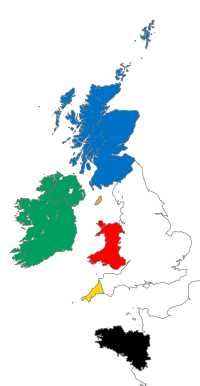 The Celts (/kɛlts/ kelts, see pronunciation for different usages) or Celtic peoples (/ˈkɛltɪk/ KEL-tick) were a collection of Indo-European peoples in Europe and Anatolia, identified by their use of Celtic languages and other cultural similarities. Major Celtic groups included the Gauls; the Celtiberians and Gallaeci of Iberia; the Britons, Picts, and Gaels of Britain and Ireland; the Boii; and the Galatians. The relation between ethnicity, language and culture in the Celtic world is unclear and debated; for example over the ways in which the Iron Age people of Britain and Ireland should be called Celts. In current scholarship, 'Celt' primarily refers to 'speakers of Celtic languages' rather than to a single ethnic group. The history of pre-Celtic Europe and Celtic origins is debated. The traditional "Celtic from the East" theory, says the proto-Celtic language arose in the late Bronze Age Urnfield culture of central Europe, named after grave sites in southern Germany, which flourished from around 1200 BC. This theory links the Celts with the Iron Age Hallstatt culture which followed it (c. 1200–500 BC), named for the rich grave finds in Hallstatt, Austria, and with the following La Tène culture (c. 450 BC onward), named after the La Tène site in Switzerland. It proposes that Celtic culture spread westward and southward from these areas by diffusion or migration. A newer theory, "Celtic from the West", suggests proto-Celtic arose earlier, was a lingua franca in the Atlantic Bronze Age coastal zone, and spread eastward. Another newer theory, "Celtic from the Centre", suggests proto-Celtic arose between these two zones, in Bronze Age Gaul, then spread in various directions. After the Celtic settlement of Southeast Europe in the 3rd century BC, Celtic culture reached as far east as central Anatolia, Turkey. (Full article...) |